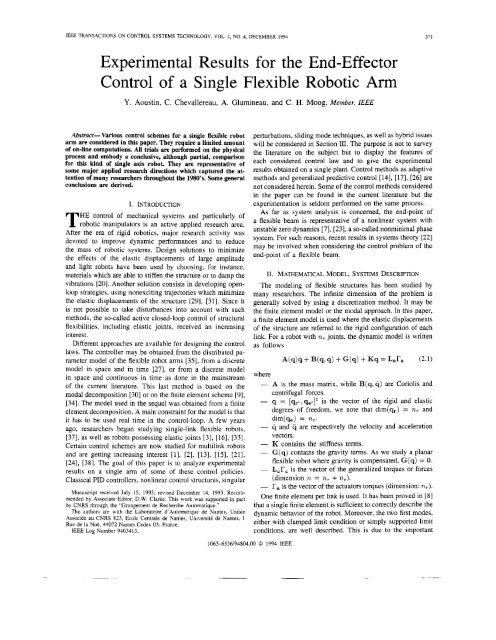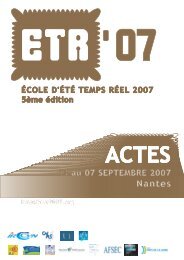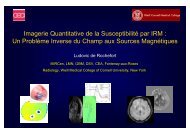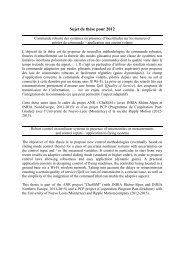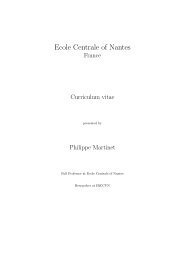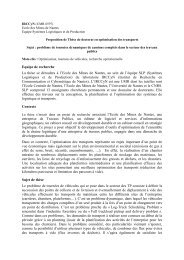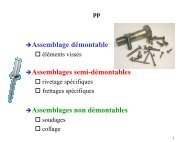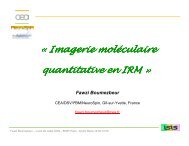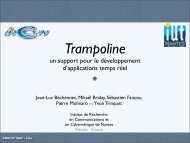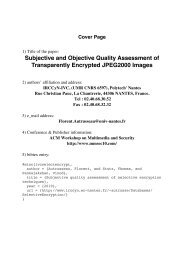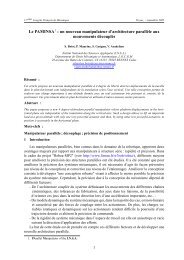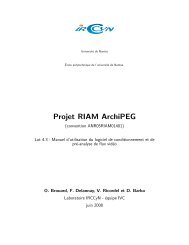View - IRCCyN - Ecole Centrale de Nantes
View - IRCCyN - Ecole Centrale de Nantes
View - IRCCyN - Ecole Centrale de Nantes
You also want an ePaper? Increase the reach of your titles
YUMPU automatically turns print PDFs into web optimized ePapers that Google loves.
qetIt<br />
IEEE TRANSACTIONS ON CONTROL SYSTEMS TECHNOLOGY, VOL. 2, NO. 4, DECEMBER 1994 371<br />
Experimental Results for the End-Effector<br />
Control of a Single Flexible Robotic Arm<br />
Y. Aoustin, C. Chevallereau, A. Glumineau, and C. H. Moog, Member, IEEE<br />
Abstract-Various control schemes for a single flexible robot perturbations, sliding mo<strong>de</strong> techniques, as well as hybrid issues<br />
arm are consi<strong>de</strong>red in this paper. They require a limited amount will be consi<strong>de</strong>red in Section 111. The purpose is not to survey<br />
of on-line computations. All trials are performed on the physical<br />
the literature on the subject but to display the features of<br />
process and embody a conclusive, although partial, comparison<br />
for this kind of single axis robot. They are representative of each consi<strong>de</strong>red control law and to give the experimental<br />
some major applied research directions which captured the at- results obtained on a single plant. Control methods as adaptive<br />
tention of many researchers throughout the 1980’s. Some general methods and generalized predictive control [14], [17], [26] are<br />
conclusions are <strong>de</strong>rived.<br />
not consi<strong>de</strong>red herein. Some of the control methods consi<strong>de</strong>red<br />
in the paper can be found in the current literature but the<br />
I. INTRODUCTION<br />
experimentation is seldom performed on the same process.<br />
As far as system analysis is concerned, the end-point of<br />
T<br />
HE control of mechanical systems and particularly of<br />
robotic manipulators is an active applied research area.<br />
After the era of rigid robotics, major research activity was<br />
<strong>de</strong>voted to improve dynamic performances and to reduce<br />
the mass of robotic systems. Design solutions to minimize<br />
the effects of the elastic displacements of large amplitu<strong>de</strong><br />
and light robots have been used by choosing, for instance,<br />
materials which are able to stiffen the structure or to damp the<br />
vibrations [20]. Another solution consists in <strong>de</strong>veloping openloop<br />
strategies, using nonexciting trajectories which minimize<br />
the elastic displacements of the structure [29],[31]. Since it<br />
is not possible to take disturbances into account with such<br />
methods, the so-called active closed-loop control of structural<br />
flexibilities, including elastic joints, received an increasing<br />
interest.<br />
Different approaches are available for <strong>de</strong>signing the control<br />
laws. The controller may be obtained from the distributed parameter<br />
mo<strong>de</strong>l of the flexible robot arms [35], from a discrete<br />
mo<strong>de</strong>l in space and in time [27], or from a discrete mo<strong>de</strong>l<br />
in space and continuous in time as done in the mainstream<br />
of the current literature. This last method is based on the<br />
modal <strong>de</strong>composition [30] or on the finite element scheme [9],<br />
[34]. The mo<strong>de</strong>l used in the sequel was obtained from a finite<br />
element <strong>de</strong>composition. A main constraint for the mo<strong>de</strong>l is that<br />
it has to be used real time in the control-loop. A few years<br />
ago, researchers began studying single-link flexible robots,<br />
[37], as well as robots possessing elastic joints [3], [16], [33].<br />
Certain control schemes are now studied for multilink robots<br />
and are getting increasing interest [l], [2],[13], [15], [21],<br />
[24],[38]. The goal of this paper is to analyze experimental<br />
results on a single arm of some of these control policies.<br />
Classical PID controllers, nonlinear control structures, singular<br />
Manuscript received July 15, 1993; revised December 14, 1993. Recommen<strong>de</strong>d<br />
by Associate Editor, D.W. Clarke. This work was supported in part<br />
by CNRS through the “Groupement <strong>de</strong> Recherche Autornatique.”<br />
The authors are with the Laboratoire d’Automatique <strong>de</strong> <strong>Nantes</strong>, Unitee<br />
Associke au CNRS 823, <strong>Ecole</strong> <strong>Centrale</strong> <strong>de</strong> <strong>Nantes</strong>. Universiti <strong>de</strong> <strong>Nantes</strong>, 1<br />
Rue <strong>de</strong> la Noe, 44072 <strong>Nantes</strong> Ce<strong>de</strong>x 03. France.<br />
IEEE Log Number 9403413.<br />
a flexible beam is representative of a nonlinear system with<br />
unstable zero dynamics [7], [23], a so-called nonminimal phase<br />
system. For such reasons, recent results in systems theory [22]<br />
may be involved when consi<strong>de</strong>ring the control problem of the<br />
end-point of a flexible beam.<br />
10634536/94$04 .Do Q 1994 IEEE<br />
11. MATHEMATICAL MODEL, SYSTEMS DESCRIFTION<br />
The mo<strong>de</strong>ling of flexible structures has been studied by<br />
many researchers. The infinite dimension of the problem is<br />
generally solved by using a discretization method. It may be<br />
the finite element mo<strong>de</strong>l or the modal approach. In this paper,<br />
a finite element mo<strong>de</strong>l is used where the elastic displacements<br />
of the structure are referred to the rigid configuration of each<br />
link. For a robot with n, joints, the dynamic mo<strong>de</strong>l is written<br />
as follows<br />
where<br />
- A is the mass matrix, while B(q: q ) are Coriolis and<br />
centrifugal forces.<br />
- q = [qPt ~ is the vector of the rigid and elastic<br />
<strong>de</strong>grees of freedom, we note that dim(q,) = n,. and<br />
dim(qe) = ne.<br />
- q and q are respectively the velocity and acceleration<br />
vectors.<br />
- K contains the stiffness terms.<br />
- G(q) contains the gravity terms. As we study a planar<br />
flexible robot where gravity is compensated, G(q) = 0.<br />
- L,r, is the vector of the generalized torques or forces<br />
(dimension n = n, + ne).<br />
- Ta is the vector of the actuators torques (dimension: nT).<br />
One finite element per link is used. It has been proved in [8]<br />
that a single finite element is sufficient to correctly <strong>de</strong>scribe the<br />
dynamic behavior of the robot. Moreover, the two first mo<strong>de</strong>s,<br />
either with clamped limit condition or simply supported limit<br />
conditions, are well <strong>de</strong>scribed. This is due to the important
312 IEEE TRANSACTIONS ON CONTROL SYSTEMS TECHNOLOGY, VOL. 2, NO. 4, DECEMBER 1994<br />
TABLE I<br />
NUMERICAL DATA OF T€E ROBOTIC SYSTEM<br />
A7<br />
Fig. 1. blexible robot.<br />
concentrated mass at the end-point of the link. In the case of a<br />
plane flexible robot, one gets three variables for each link: Oi is<br />
the rigid <strong>de</strong>gree of freedom, VB~<br />
and 8gi are the displacement<br />
and the rotation of the terminal section. They represent the<br />
<strong>de</strong>grees of freedom of the robot (see Fig. 1, with one flexible<br />
link).<br />
Vector q represents the rigid and elastic variables, q =<br />
[e VB OB]'. This mo<strong>de</strong>l is general. It can <strong>de</strong>scribe any type<br />
of robot structure. The dynamic mo<strong>de</strong>l is almost the same as<br />
for a rigid robot. The main difference is that for a rigid robot<br />
La is an (n, x n,) i<strong>de</strong>ntity matrix. The expression of matrices<br />
A, B, K are <strong>de</strong>fined in [lo], and they are given for a one-link<br />
robot as shown by A at the bottom of the page and<br />
Fig. 2. The experimental robat.<br />
and 2.43 Hz. They correspond to zeros of the transfer of the<br />
approximate linearized mo<strong>de</strong>l as presented in Section 111-C<br />
between the torque and the rigid variable. The experimental<br />
(planar) robot is shown in Fig. 2. The rotational joint is parallel<br />
to the direction of gravity. The extremity of the link has air<br />
bearings to avoid gravity effects.<br />
The mechanical characteristics of the robot un<strong>de</strong>r interest<br />
were i<strong>de</strong>ntified on the plant in Table I.<br />
In the experimental <strong>de</strong>vice, the first vibration mechanical<br />
structural mo<strong>de</strong>s of our robot are at frequencies 0.264 Hz<br />
111. EXPERIMENTED CONTROL SCHEMES<br />
The physical process has some differences with the mathematical<br />
mo<strong>de</strong>l given in Section IT, higher frequency mechanical<br />
mo<strong>de</strong>s as well as constant friction are unmo<strong>de</strong>led.<br />
Coulomb friction is, however, i<strong>de</strong>ntified, and its average value<br />
equals 0.140 Nm on the actuator output axis. Unfortunately,<br />
this friction factor <strong>de</strong>pends of the axis position. So, its compensation<br />
is a difficult matter. A continuous mo<strong>de</strong>l is used<br />
to <strong>de</strong>fine the control law using a HP 1000 A 900 computer<br />
and the sampling period is 5 ms. The hardware architecture<br />
is presented in Fig. 3.<br />
The sensors are a tachometer to measure 8, an enco<strong>de</strong>r<br />
to measure 6, and strain gauges which 'are located on the<br />
links to measure <strong>de</strong>formation of the link in two particular<br />
places. So the elastic variables and their time <strong>de</strong>rivatives<br />
are computed, from the strain-gauges information, by using<br />
-<br />
p LI+-<br />
"31<br />
A= p I + -SL + m,L<br />
SL3<br />
+~,(L*+V~)+J~+J~ p +mcL - p y + J ~<br />
[ z'o 2]<br />
SL3<br />
- P m + JB<br />
-p [-+-<br />
:o-<br />
SL3<br />
4,+15]+JB<br />
ll;foLz]<br />
2LI
AOUSTIN et al.: RESULTS FOR THE<br />
the finite element mo<strong>de</strong>l. This computation is valid only if<br />
V, is within a range of 10% of the length of the arm.<br />
This yields the choice of the reference trajectory adopted<br />
in the rest of this paper. Analogical antialiasing filters and<br />
numerical filters limit spillover noise on the measurements.<br />
The input torque <strong>de</strong>livered by the electric actuator is boun<strong>de</strong>d<br />
to 2 Nm. The results given in the rest of this section are<br />
obtained from the implementation on the robot system. The<br />
measurements are filtered after the first mo<strong>de</strong> (at 0.3 Hz),<br />
before the computation of the velocities d s and $b, to avoid<br />
un<strong>de</strong>sired high frequencies.<br />
A. The Desired Trajectory<br />
The <strong>de</strong>sired trajectory for the end-effector of the link is a<br />
fifth-or<strong>de</strong>r equation which is <strong>de</strong>fined by<br />
Yd(t) = yi + dr(t) (3.1)<br />
where yi is the initial position, d is the displacement, yd is<br />
the current <strong>de</strong>sired position, and r(t) is a function of the time.<br />
The <strong>de</strong>sired positions of the elastic variables are zero since<br />
the fulfillment of the trajectory yd(t) without stabilization of<br />
the elastic variables is not acceptable; the orientation of the<br />
end-effector would remain unstable.<br />
To <strong>de</strong>fine a trajectory which is smooth and continuous in<br />
position, velocity, and acceleration, we choose<br />
END-EFFECTOR<br />
CONTROL OF ROBOTIC ARM 373<br />
Calculator<br />
HPlwO AWO<br />
-<br />
1 ’ 7<br />
C.A.D. : malogicdigital convertex<br />
C.D.A. : digira-andogic converter<br />
I.D. : counting card<br />
Fig. 3. Hardware architecture.<br />
Actuator 1<br />
ARTIJS<br />
“2wO<br />
Tachymemc<br />
dynamo<br />
Enco<strong>de</strong>r<br />
Strain gauges<br />
amplificator<br />
gauges Link Strain<br />
where T, is the expected duration of the motion. With this<br />
equation, the <strong>de</strong>sired velocity and acceleration at the initial<br />
and final position are zero. T, is computed as a function of<br />
the maximal admissible velocity and acceleration of the link.<br />
This type of trajectory allows the <strong>de</strong>finition of a <strong>de</strong>sired<br />
velocity and a <strong>de</strong>sired acceleration during the whole time of<br />
the displacement. They may eventually be used in the control<br />
law. On the other hand, the elastic <strong>de</strong>flections are less excited<br />
than by a step reference, and they have a more acceptable<br />
response. This trajectory avoids saturation of the actuators at<br />
initial conditions. These advantages justify its frequent use in<br />
robotics. The tested trajectory is ‘yi = 0 rd, d = 1.57 rd, T, =<br />
7.36 s.<br />
B. PD Controller<br />
Consi<strong>de</strong>ring the position of the end-point (LO + VB), one<br />
<strong>de</strong>als with a nonminimum phase system [7], [23] and the<br />
PD control <strong>de</strong>rived from this output (LO + V,) yields an<br />
unstable closed-loop system. The rigid angle O as an output<br />
<strong>de</strong>fines a minimum phase system. A classical proportional and<br />
<strong>de</strong>rivative controller for this output has been tested and will be<br />
used as reference in the controller performance comparison.<br />
The best tuning of such a controller yields a response time<br />
of about 13 s for a fifth-<strong>de</strong>gree polynomial input; <strong>de</strong>creasing<br />
this response time with another tuning causes serious troubles,<br />
since the flexible mo<strong>de</strong>s would be activated and the dynamical<br />
behavior of the end-effector of the robot would no longer be<br />
acceptable. This tuning is Kp = 2 and K, = 7 in<br />
-0.5 I I I<br />
1’0 15 i0<br />
tim*<br />
Fig. 4. PD controller: Reference (- - - -, rn) and end-effector (-, rn) versus<br />
time (3).<br />
where Od is computed from Yd with 1’8 = 0. The break<br />
frequency of this corrector is at low frequencies, so it acts like<br />
a forward phase shift of 90 <strong>de</strong>grees for almost all frequencies.<br />
In the next figures, the dotted line represents the <strong>de</strong>sired<br />
trajectory yd, the position of the end-effector, and the solid line<br />
represents the measured variables. In Fig. 4, the end-effector<br />
response (LO + VB) to the PD controller (3.2) is displayed and<br />
the corresponding input torque is given in Fig. 5.<br />
A slight modification of this control low is consi<strong>de</strong>red below<br />
and is called “speed feedback” hereafter<br />
In both cases, there is a static error which is due to the<br />
friction effects. Usually it is possible to cancel this error using<br />
an integral term. A compromise between the behavior of the<br />
controller at low and high frequencies, however, has to be<br />
sought. Some large overshoots, <strong>de</strong>pending on the trajectories,<br />
may appear with nonlinear systems. The flexibilities of the<br />
robot consi<strong>de</strong>red in this paper are greater than standard flexibil-<br />
Fa = Kp(ed - 0) + K,(dd - 6) (3.2) ities which occur in industrial applications. This implies some
374 IEEE TRANSACTIONS ON CONTROL SYSTEMS TECHNOLOGY, VOL. 2, NO, 4. DECEMBER 1994<br />
2- C. LQR Controller<br />
The torque is <strong>de</strong>fined by<br />
1-<br />
ra = -Kv(q - qd) - Kp(q - qd) (3.4)<br />
where K,, K, are (1 x 3) matrices; the measurement or<br />
8 0-<br />
8 estimation of all the state variables is necessary.<br />
The gain matrices K, and K, are obtained from a LQR<br />
method, minimizing the following criterion<br />
-1-<br />
-2 c=~~{(q-qd)'Ql(q-qd)+(q-Pd)*Q~(q-qd)<br />
, , , .<br />
Fig. 5. PD controller: Torque (-, .Vm) versus time (8).<br />
J<br />
r--------___-----______<br />
1.5 -<br />
lb lls ia<br />
tima +r:Rr,)}dt (3.5)<br />
,<br />
where Q1, Qz, are semi<strong>de</strong>finite positive and R is <strong>de</strong>finite positive.<br />
Such a method ensures proper gain and phase margins.<br />
The weighting matrices are associated to the state and control<br />
variables and yield the computation of a state feedback. Thus<br />
it is necessary to <strong>de</strong>fine a <strong>de</strong>sired state trajectory, even if the<br />
output is yd. To apply this method, we use an approximate<br />
linearized mo<strong>de</strong>l of the robot. We linearize the dynamics<br />
around an equilibrium point of the robot so that q, = 0, and<br />
q = 0. The linearized mo<strong>de</strong>l that one obtains is in<strong>de</strong>pen<strong>de</strong>nt<br />
on the rigid variable B<br />
-0.5 I I .<br />
,<br />
lb<br />
lime<br />
t<br />
15 20<br />
Fig. 6. Speed feedback: Reference (- - - -, m) and end-effector (-, m)<br />
versus time (s).<br />
The closed-loop behavior of the flexible robot is <strong>de</strong>fined by<br />
2- From the form of K and qd, K q can be replaced by<br />
K(q - qd). The robot can be consi<strong>de</strong>red as three coupled<br />
second-or<strong>de</strong>r systems submitted to the disturbance given by<br />
1- the right-hand si<strong>de</strong> of (3.7). The weighting matrices have<br />
f 0-<br />
been <strong>de</strong>signed using the Bryson rule [6] so that the maximal<br />
admissible torque and the maximal admissible <strong>de</strong>flection of<br />
the link are respected<br />
-1-<br />
Q1 = diag(lO.l, 1): Q z = diag(l.1,l). R = 1<br />
the corresponding solution is<br />
-2- . , , ,<br />
10 15 ' ' io K,= [3.16 - 5.83 4.531 and Kv=[6.27 5.16 - 0.741.<br />
lime<br />
Fig. 7. Speed feedback Torque (-, N. m) versus time (s).<br />
So the control laws are<br />
overshoots in several cases and in particular for PD control,<br />
the situation would become worse with the adjunction of an<br />
integral term. No integral action has been implemented. The<br />
overshoot obtained with the PD controller (3.2) can eventually<br />
be cancelled by modifying the tuning, but it was kept to<br />
compare the controls (3.2) and (3.3). It is worthwhile to point<br />
out a particular poor behavior which characterizes the above<br />
PD controller, w.r.t. the next controllers, since it is heavily<br />
sensitive to disturbance forces; when the robot is hit, some<br />
severe oscillations will occur and be maintained. An extension<br />
of such a PD controller <strong>de</strong>sign to a two-flexible link robot can<br />
be done uniquely by consi<strong>de</strong>ring in<strong>de</strong>pen<strong>de</strong>nt arms.<br />
or<br />
ra = 3.16(ed - e) + 6.27(ed - e) + 5 .83~~<br />
- 5.16V~ - 4.538B + 0.748~ (3.8)<br />
ra = 3.16(~~ - e) - 6.278 + 5 .83~~ - 5.16VB<br />
- 4.530~ + 0.748~. (3.9)<br />
For the single link robot and in the experimental test, the<br />
response of the control law (3.8) and the response of the<br />
control law (3.9) are, respectively, displayed in Figs. 7 and<br />
9. The advantage of this controller, w.r.t. the PD controller,<br />
is that it remains insensitive to external disturbances. For an
AOUSTIN er ai.: RESULTS FOR THE END-EFFECTOR CONTROL OF ROBOTIC ARM 375<br />
1.5<br />
“i 1.5 /<br />
1 I /<br />
0.5<br />
0.0<br />
-0.5 , , , ,<br />
10<br />
time<br />
15 d0<br />
Fig. 8. LQR controller (Tal): Reference (- - - -. m) and end-effector (-,<br />
rn) versus time (5).<br />
-0.1 , I I , I<br />
10 15 20<br />
lime<br />
Fig. 10.<br />
versus time (s).<br />
LQR controller (ra2): Reference(--, m) and end-effector (-, m)<br />
-2 , , , ,<br />
Fig. 9. LQR controller (Tal): Torque (-,<br />
lb lh 2b<br />
tima<br />
.Vm) versus time (s).<br />
-1<br />
-2’ , , , z<br />
Fig. 11.<br />
10 15 20<br />
time<br />
LQR controller (ra2): Torque (-, .h‘m) versus time (5).<br />
extension to a two-flexible link robot, the linearized mo<strong>de</strong>l<br />
<strong>de</strong>pends on the configuration of the robot.<br />
From (3.7) a LQR control yields a linear closed-loop system<br />
subject to a “nonlinear disturbance.” A nonlinear control can<br />
be introduced besi<strong>de</strong>s the LQR control for minimizing the<br />
effect of the disturbance, so that the closed-loop behavior<br />
approaches<br />
or<br />
6 -t Kvlq + Kpl(q - qd) = 0 (3.10)<br />
(6- qd) + KvI(~<br />
- ‘id) + Kpl(q - qd) = 0. (3.11)<br />
Since there are nonlinear equations relating 8, VB, OB, and q,<br />
neither (3.10) nor (3.11) can be exactly matched. So one looks<br />
for the torques Ta which minimize the “distance” between the<br />
real behavior of the robot and the <strong>de</strong>sired behavior. The real<br />
behavior of the robot is <strong>de</strong>fined by (2.1)<br />
4 = A(q)-’[Lara - B(q, 4) - Kq]. (3.12)<br />
This “distance” is <strong>de</strong>fined by the norm of the difference<br />
between the values of q calculated by (3.10) and (3.12) or<br />
(3.11) and (3.12). For instance, using (3.12) in the left-hand<br />
si<strong>de</strong> of (3.10), the criterion to minimize is<br />
c1 = II{A-l[Lara - B(q, 4 - Kql + K”l4<br />
+ Kpl(q- qd)>11*. (3.13)<br />
This norm is<br />
minimal for<br />
ra = {A-’La}+{A-’(B(q, qj + Kqj<br />
- Kv1c1- Kpl(q - qd)}. (3.14)<br />
Since A-lL, is not invertible, full disturbance rejection is<br />
not possible. With the nonlinear control law (3.14), the effect<br />
of the disturbance on q is minimized, and from a mathematical<br />
point of view, the disturbance is orthogonally projected onto<br />
the kernel of (A(q)-IL,)+. Thus, in general, the effect of<br />
the disturbance will be less important for the nonlinear control<br />
law than for the case where the LQR linear control law only<br />
is applied.<br />
In [12], it is shown that the above LQR controller is improved<br />
for multijoints robots, when a disturbance minimization<br />
scheme is implemented. This control law reduces the variation<br />
of A(q)-lL,K,, A(qj-’{L,K,+K} along the trajectories.<br />
For completeness, this modification has been tested on the<br />
single arm robot in the following way. It has not shown to<br />
yield a significative benefit for our single link robot. As stated<br />
at the beginning of this section, from the flexibility of the<br />
robot, the speed of motion is not large and the nonlinear terms<br />
are not dominant.<br />
D. Feedback Linearization Techniques<br />
From recent <strong>de</strong>velopments of nonlinear system theory, a<br />
concept of zero dynamics has been <strong>de</strong>fined [7], [23] and
376 IEEE TRANSACTIONS ON CONTROL SYSTEMS TECHNOLOGY, VOL. 2. NO. 4, DECEMBER 1994<br />
shown to play a role that is quite similar to the linear case;<br />
as a by-product, the standard exact linearization techniques<br />
via feedback, correspond to the linear pole-zero cancellation<br />
phenomenon. More precisely and in the particular case of<br />
the robot, it is possible to perform the input-output feedback<br />
linearization when consi<strong>de</strong>ring the end-point position LO + V,<br />
as output, but this control policy yields unstable unobservable<br />
dynamics. The relative <strong>de</strong>gree of this output function is two,<br />
thus the unobservable subsystem has dimension four after<br />
feedback linearization and is unstable for this particular choice<br />
of output. Thus, elementary feedback linearization techniques<br />
can be applied only on other outputs as the so-called rigid<br />
variables, e.g., [ll].<br />
The output 6’ has relative <strong>de</strong>gree 2, then the rigid acceleration<br />
is given by<br />
= Lq = LA-l{L,r, - B(q,q) - Kq} (3.15)<br />
with L = [l 0 01 and solve in Fa this equation to get<br />
.. ..<br />
0 = 0d - Ky(b - ed) - Kp(O - 6’d). (3.16)<br />
I<br />
1<br />
30 5.00 15.0 20.0<br />
T1O.O<br />
Fig. 12. Feedback linearization of 8: 0 rigid angle (-, m) versus time (s).<br />
This yields<br />
ra = (LA-~L,)-~{&- K,(B - id) - ~ ~ - ( ed) 0<br />
- LA-lB(q, q) - LA-lKq)}. (3.17)<br />
For this control law, the matrix A, its inverse and the vector B<br />
must be computed at each sampling time. The response of the<br />
system is not sensitive to the second-or<strong>de</strong>r elastic terms of A<br />
and B. This simplification reduces dramatically the complexity<br />
of the computation of Fa which becomes<br />
ra = o .o~q& + ~ ~ - e) ( + K,(& 0 - ~ e)}<br />
+ 7.225 VBP - 0.0515 6’88’.<br />
(0 - 0d) behaves as a second-or<strong>de</strong>r system and since its<br />
initial condition is zero, Kp, and K, have no influence on<br />
the simulation response; the rigid angle B perfectly tracks the<br />
command.<br />
Fig. 12 shows the behavior of 0 which is perfect whereas<br />
nonasymptotically stable oscillations appear in the behavior of<br />
the elastic variables. The displacement of the end-point of the<br />
beam is not acceptable but is a nice practical illustration of<br />
the notion of unstable transmission zero.<br />
A conclusive remark for further application of exact feedback<br />
linearization should go through a mo<strong>de</strong>ling of structural<br />
damping (even if small) of the flexible variables which will<br />
improve the behavior of the end-point (LO + V,) without<br />
<strong>de</strong>creasing the performance on 6’. The major advantage of<br />
this feedback linearization is the easy practical choice for<br />
the tuning parameters Kp and K, characterizing the linear<br />
second-or<strong>de</strong>r system. This is not the case for the <strong>de</strong>sign of<br />
weighting matrices in a LQR method or for <strong>de</strong>signing a PID<br />
controller. Feedback linearization requires a good knowledge<br />
of the mo<strong>de</strong>l, however, and this is a task which is difficult to<br />
fulfill, due in particular to the damping phenomena.<br />
s<br />
-’<br />
u<br />
In<br />
m<br />
a51<br />
0<br />
n,l<br />
’ 0.00 5.00 15.0 20.0<br />
TlO.O<br />
Fig. 13. Feedback linearization of 8: end-effector (-, m) versus time (3).<br />
E. Singular Perturbation Method<br />
In robotics, singular perturbation theory is applied for<br />
controlling the flexible joint robots [33] or the flexible link<br />
robots [25], [30]. An overview of the subject is provi<strong>de</strong>d in<br />
[19]. The so-called rigid variables are slow, and the elastic<br />
variables result from the superposition of a slow mo<strong>de</strong> and a<br />
fast mo<strong>de</strong>.<br />
To apply the singular perturbation method to these problems,<br />
the elastic forces are introduced as new state variables. In [331,<br />
these new state variables are based on the product of a spring<br />
term that represents the joint flexibilities, and the difference<br />
occumng in the position of each link w.r.t. its actuator. The<br />
actuator position is divi<strong>de</strong>d by the gear ratio. In [30], which<br />
illustrates our problem, the author <strong>de</strong>fines the elastic forces,<br />
z = kq,: where 5 is a positive common scale factor such as<br />
K = kK.
AOUSTIN et a[.: RESULTS FOR THE OF ROBOTIC END-EFFECTOR ARM CONTROL<br />
311<br />
The variables x2 and u can be <strong>de</strong>composed in a slow and<br />
fast part [36]. The torque which is applied to the robot to<br />
track the trajectory induces a slow dynamics for the variable<br />
x1 whereas x2 results from the superposition of a slow mo<strong>de</strong><br />
xzS and a fast mo<strong>de</strong> xzf<br />
xz(t0) = XZf(0) + xzs(t0)<br />
u(h) = Uf(0) fus(t0).<br />
0 1<br />
m' I<br />
IO.00 5.00<br />
T1O.O<br />
Fig. 14. Feedback linearization of 8: Torque (-,<br />
15.0 20.0<br />
Tm) versus time (s).<br />
I<br />
The fast subsystem is given by<br />
dxl<br />
= EF(x1.x2f(T) +xzs:uf(~) + us,&) (3.22a)<br />
(.-<br />
=<br />
G(XI! Xzf(T) + xzs, uf(T) + us: E ) (3.22b)<br />
dr<br />
where xis. and us are assumed to be constant.<br />
Now it is possible to propose a computation of the two<br />
control parts. We may begin by the slow control part us. To<br />
compute us we can rewrite (3.21a) un<strong>de</strong>r the form (3.23)<br />
One can write<br />
B1 and BS have respectively the dimension (n, x I) and<br />
(ne x 1).<br />
Since the mass matrix is symmetric positive <strong>de</strong>finite, its<br />
inverse is also symmetric positive <strong>de</strong>finite. Let them be <strong>de</strong>fined<br />
as<br />
Remarks:<br />
- When E equals to 0, A and W are uniquely function of<br />
xls. The subscript "s" stands for the evaluation of the<br />
different matrices at q, = 0.<br />
- For one flexible link robot we can note that B1,<br />
(qr, 0, qr, 0) and B~s(qr, O,qr> 0) are equal to 0.<br />
is <strong>de</strong>termined by the computed torque method for a<br />
rigid robot requiring that the system tracks a <strong>de</strong>sired<br />
trajectory.<br />
(3.18)<br />
E is equal to &.<br />
By writing the system (3.18) un<strong>de</strong>r the state form we obtain<br />
(3.19a)<br />
(3.19b)<br />
x1 and xz are, respectively, joined to slow and fast variables<br />
and are equal to<br />
We choose the gain such as K,, = 2 6 to obtain a damping<br />
factor that is equal to one. The knowledge of us allows to<br />
<strong>de</strong>termine xzS<br />
Concerning the fast part uf. after some computations, (3.22b)<br />
becomes<br />
(3.20)<br />
which correspond, respectively, to rigid and elastic variables;<br />
u, the control term is, of course, Tu. We consi<strong>de</strong>r a slow<br />
subsystem with the scale time (t) and a fast subsystem with<br />
the scale time (T) [28], so that T = (t - to)/€. The slow<br />
subsystem is obtained by setting E = 0. The n2 differential<br />
equations (3.19b) become algebraic. We have now [4], [5]<br />
(3.21a)<br />
(3.21b)
378 IEEE TRANSACTIONS ON CONTROL SYSTEMS TECHNOLOGY, VOL. 2, NO, 4, DECEMBER 1994<br />
Fig. 15. Singular perturbations controller: Reference (- - - -, m) and<br />
end-effector (-, m) versus time (5).<br />
Fig. 16. Singular perturbations controller: Torque (-, .Vm) versus time (3).<br />
Then one <strong>de</strong>duces<br />
= (1- KR1K-1A21sA;~s)~s - KR [:gel<br />
Finally the numerical parameters of the computed torque<br />
for one flexible link robot are<br />
ra = 7.264[(& - o m(8 - id) - o.qe - ed)] + 0.4125 vB<br />
+ 0.1547 VB - 0.2544 95 + 0.2078 8,. (3.27)<br />
Note that in (3.27), in opposition to the other control laws,<br />
there is no term <strong>de</strong>pending on q,+, since the <strong>de</strong>composition<br />
into two subsystems neglects the couplings between slow and<br />
fast variables. To verify the two-time scale separation of the<br />
slow and fast closed-loop systems, one neglects the couplings<br />
and the system (3.19) becomes linear. The dynamics of (3.28a)<br />
must be much slower than those in (3.28b)<br />
(3.28a)<br />
(3.28b)<br />
One chooses eigenvalues such that [18] X(AI~),,,~~ 5<br />
X (E-~AZZ) min.<br />
Fig. 14 displays a good trajectory tracking for the end-point<br />
of the robot. The final position is reached in about 10 seconds,<br />
however, there is a 2.5% static error. It is possible to add an<br />
integral term in the control law, but it would increase the<br />
overshoot on the end-point response. The computed torque<br />
is comparable to the ones obtained with the other control<br />
schemes. It satisfies the bounds on the maximal torque which<br />
is equal to 2 Nm. The experiments show that the torque uf is<br />
small with respect to us, this is usual in practice.<br />
The singular perturbation method induces some mo<strong>de</strong>l simplifications,<br />
which yield in our case the <strong>de</strong>sign of simplified<br />
Fig. 17. Shape<br />
of the Sign1 function.<br />
controllers. A simple-computed torque control is implemented<br />
for the slow subsystem and a restricted state feedback is used<br />
for the fast subsystem. The main advantage of this method<br />
(w.r.t. Section 111-D) is to <strong>de</strong>crease the on-line computations,<br />
and this point becomes particularly crucial for multijoint<br />
robots.<br />
F. Sliding Mo<strong>de</strong>s Techniques<br />
Sliding mo<strong>de</strong>s controllers are quite appealing since they<br />
are <strong>de</strong>signed for robust control which is of major importance<br />
in practical experiments. Recall the basic and fundamental<br />
principles. Choose a so-called sliding surface .(x), which<br />
can be consi<strong>de</strong>red as an output whose relative <strong>de</strong>gree equals<br />
one, Le., di(a! u)/du # 0. Consi<strong>de</strong>r the Lyapunov function<br />
V(x) = 1/2s2(2) and solve in 'LL<br />
V(x,u) 5 0. (3.29)<br />
The goal is to <strong>de</strong>sign a control u which drives the state 2<br />
of the system onto the surface s(z) = 0. The equilibrium on<br />
the sliding surface has to yield the physical control objectives.<br />
Besi<strong>de</strong>s this constraint, the practical implementation of such<br />
a control is feasible only if 9(2) <strong>de</strong>fines a minimum phase<br />
system when consi<strong>de</strong>red as an output, otherwise the motion<br />
restricted on the surface s(x) = 0 is unstable.<br />
To solve (3.29), it is possible to write u = .ueq + un<br />
where ueq is the solution V(z,u) = 0. Set V(x! u) =<br />
VI(.) + v2(x)u, then<br />
ueq = -V1(.)/Vz(.)<br />
and a class of solutions to (3.29) u, is given by<br />
un = -k sign(Vz(z)), k > 0.<br />
....
:I /r\<br />
1 . , . , . , . . . . . , . . . .<br />
dbw<br />
Fig. 19. Sliding mo<strong>de</strong>s techniques: Torque (-, A‘mj versus rime (8).<br />
There is bang-bang type term un in the control which does<br />
not cause a major trouble in the numerical simulation when<br />
applied to the mo<strong>de</strong>l of the robot given in Section 11. For the<br />
practical implementation on the physical system, however, the<br />
actuators can not perform instantaneous commutations. Due<br />
to the chattering phenomenon, the results are not as expected.<br />
This can be largely improved by doing the computation of<br />
sliding mo<strong>de</strong> controller which takes into account a mo<strong>de</strong>l of<br />
the actuators, even very elementary. This is done next since it<br />
is particularly crucial in this section. The actuator is mo<strong>de</strong>led<br />
by a first or<strong>de</strong>r system.<br />
Let s(z) = - 0,) + PVB + 8. (3.30)<br />
The signs of parameters ctl and ,f3 <strong>de</strong>termine the stability<br />
of the closed-lopp system and their values the response time.<br />
In the frame of sliding mo<strong>de</strong>s, the so-called equivalent control<br />
ueq solves the equation i = 0 and thus, is the feedback control<br />
which linearizes the “output” s(x)<br />
ueq =<br />
(a(id - 8) - /?I&)(V; + 1.65E - 3)<br />
0.147<br />
(7.3~5 - 38B - 1.06V~)e’ - 2.3188 f<br />
-<br />
6.16V~<br />
0.147<br />
(3.31)<br />
with cz = 0.35,,8 = -2.<br />
As recalled previously, the standard sliding mo<strong>de</strong>s technique<br />
induces some un<strong>de</strong>sirable chattering in the control. These high<br />
frequency commutations are created when the state trajectory<br />
of the System is close to the sliding surface and then the<br />
value of sign function changes often. To <strong>de</strong>crease the effect<br />
of chattering, some classical issues are experimented in the<br />
modification of the u, term of the control. The first one is<br />
as follows<br />
u, = -k sign(Vz(z)) = -k sign(s(a)): k 2 0,<br />
if s(z) e] - E. +E[, E = constant<br />
un = 0: if s(z) E] - E, +E[.<br />
The parameter E is <strong>de</strong>termining for the chattering in the closedloop<br />
system. A too-large value of E, however, will <strong>de</strong>crease<br />
the performance. To <strong>de</strong>crease the chattering even more, we<br />
will adopt an alternative method for <strong>de</strong>signing the u, term<br />
of the control. As done in [32], we use another continuous<br />
function, say Signl, to replace the sign function. The results<br />
are obtained with a = 0.35, /3 = -2, and E = 0.035.<br />
Concerning the tuning of the controller, the sliding mo<strong>de</strong>s<br />
scheme has the same level of simplicity as the exact feedback<br />
linearization techniques (Section 111-D) but is more robust.<br />
The main point which is argued in this context concerns<br />
the <strong>de</strong>finition of the sliding surface equation s(.c). This is<br />
solved in the robot system by <strong>de</strong>fining a “minimum phase”<br />
output function. Despite the u,, term of the control has been<br />
smoothened, the control is still sensitive to the noise on the<br />
variable Vg which was filtered.<br />
IV. CONCLUSION<br />
The strength of the paper relies in the experimental results<br />
comparison performed (in a partial way) for various nonadaptive<br />
control schemes. Five controllers have been tested on a<br />
robot whose flexibilities are greater than standard flexibilities<br />
which occur in industrial applications. The goal of this study<br />
is to <strong>de</strong>rive some general conclusions valid for a whole class<br />
of systems as flexible robots. The plant is not an industrial<br />
robot in the sense that its flexibility is intentionally large.<br />
The reference trajectory has been chosen to avoid physical<br />
limitations of the drive; otherwise, on the one hand, the<br />
comparison of the different methods would be meaningless<br />
and, on the other hand, one could not avoid permanent<br />
<strong>de</strong>formations of the link.<br />
For feedback linearization and LQR with disturbance minimization,<br />
an on-line matrix inversion is necessary if the matrix<br />
A <strong>de</strong>scribed in Section I1 is used. A constant matrix A requires<br />
only an off-line inversion to compute the torque r. For a<br />
multilinks robot, a constant matrix A can not be used. Note<br />
that an on-line matrix inversion for All is also necessary in<br />
the case of several joints with the singular perturbation method<br />
to compute Xas.<br />
In the present state of the investigations, the singular perturbations<br />
method appears to provi<strong>de</strong> the best tracking of the<br />
reference trajectory. This is a byproduct of the time scale<br />
<strong>de</strong>composition which yields a direct tuning of the 8 dynamics<br />
which is not disturbed by the flexible mo<strong>de</strong>s. There is a<br />
steady-state error, however, which can be eventually improved<br />
by switching to another control scheme <strong>de</strong>signed for the<br />
regulator problem. The sliding mo<strong>de</strong>s technique can eventually
380 IEEE TRAKSACTIONS ON CONTROL SYSTEMS TECHNOLOGY, VOL. 2, NO. 4, DECEMBER 1994<br />
TABLE I1<br />
be improved for the tracking purpose by including a constraint<br />
on 6’ in the sliding surface <strong>de</strong>finition. The parameters of any<br />
control scheme have to be tuned in a final phase on the<br />
physical process, and this point becomes a real difficulty for<br />
the practical implementation of the LQR method since many<br />
parameters are involved in the weighting matrices of the cost<br />
function.<br />
Future work should consi<strong>de</strong>r an uncertainty on a load ad<strong>de</strong>d<br />
at the end-effector of the beam. This was partly done for<br />
the sliding mo<strong>de</strong> control and that it showed to be able to<br />
cope with such an heavy uncertainty. No significant change of<br />
the dynamical behavior is noticed for a load mass up to 500<br />
g. Some persistent oscillations appear when the mass of the<br />
load is as large as 1 kg. More generally, the different control<br />
methods studied herein feature robustness since they show<br />
their ability to cope with i<strong>de</strong>ntification errors and uncertainties<br />
which have not been mo<strong>de</strong>led as Coulomb friction which is<br />
not constant along the trajectory. The conclusions from our<br />
experiments are summarized in Table 11.<br />
The purpose was to test some controllers which are fully<br />
<strong>de</strong>signed off line in the sense that there is no heavy computational<br />
task to be performed on line. The latter discussion<br />
could be started when consi<strong>de</strong>ring, for instance, some larger<br />
adaptive control structures which could recompute the tuning<br />
parameters of the various controllers to improve their robustness<br />
properties. In such a situation, some new severe problems<br />
would arise, however, such as the stability of the overall<br />
structure. So, it is important to notice the intrinsic advantages<br />
and limits of each elementary controller as done in Section 111.<br />
The extension to rnultilink robots is feasible in principle<br />
for all control procedures. Except for PD control, it is natural<br />
to perform analysis on the global system. For a PD, tuning<br />
consists in <strong>de</strong>signing controller parameters link by link.<br />
REFERENCES<br />
Y. Aoustin, P. Chedmail, C. Chevallereau, A. Froment, and M. Faillot,<br />
“Control of a robot with flexible links,” in Pmc. Int. Conf ICAR ‘91,<br />
Pise, Italy, 1991, pp. 114-1 17.<br />
Y. Aoustin and C. Chevallerean, “The singular perturbation control<br />
of a two-flexible-link robot,” in Proc. IEEE ICRA, Atlanta, 1993, pp.<br />
737-742.<br />
A. Benallegue, “Contribution d la cornrnan<strong>de</strong> dynamique adaptative <strong>de</strong>s<br />
robots rnanipulateurs rapi<strong>de</strong>s,” Ph.D. dissertation, Paris VI Univ., 1991.<br />
P. Borne, G. Dauphin-Tanguy, 3. P. Richard, F. Rotella, and I. Zambettakis,<br />
“Collection mkthod et techniques <strong>de</strong> I’ingenieur,” in Comman<strong>de</strong><br />
et Oprimisation <strong>de</strong>s Processus, Editions Technip, Paris, 1990.<br />
P. Borne, G. Dauphin-Tanguy, J. P. Richard, F. Rotella, and I. Zambettakis,<br />
“Collection mdtho<strong>de</strong>s et techniques <strong>de</strong> l’ingdnieur,” Moddisarion<br />
et I<strong>de</strong>nfiJication <strong>de</strong>s Processus, Editions Technip, Paris. 1992.<br />
A. E. Bryson, Jr. and Y. C. Ho, Applied Optimal Control. Hemisphere<br />
Publishing, 1992, pp. 328-338.<br />
C. I. Byrnes and A. Isidori, “Local stabilization of minimum-phase<br />
nonlinear systems,” Syst. Contr. L eft, vol. 11, pp. 9-17, 1992.<br />
P. Chedmail, “Synthkse <strong>de</strong> robots et <strong>de</strong> sites robotisks-moddlisation <strong>de</strong><br />
robots souples,” Ph.D. dissertation, E.N.S.M., <strong>Nantes</strong>, 1990.<br />
P. Chedmail and G. Michel, “Mo<strong>de</strong>lisation of plane flexible robots,” in<br />
Proc. 15th ISIR, Tokyo, Japan, 1992, pp. 1083-1090.<br />
P. Chedmail, Y. Aoustin, and C. Chevallereau. “Mo<strong>de</strong>ling and control of<br />
flexible robots,” Int. J. Numerical Mefh. Eng., vol. 32, pp. 1595-1619,<br />
1991.<br />
P. Chedmail, A. Glumineau, and J. C. Bardiaux, “Plane flexible mo<strong>de</strong>ling<br />
and application to the control ofan elastic am,” in Proc. ICAR<br />
’87, Versailles, France, 1987, pp. 525-536.<br />
C. Chevallereau and Y. Aoustin, “Nonlinear control laws for a two<br />
flexible links robot: Comparison of applicability domains,” in Proc.<br />
IEEE RA-92 Nice, France, 1992, pp. 748-753.<br />
C. Chevallereau and Y. Aoustin, “Nonlinear control of a two flexible<br />
links robot: Experimental and theoretical comparisons,” in Proc. ECC<br />
’91, Grenoble, France, 1987, pp. 1051-1056.<br />
D. W. Clarke, “Application of generalized predictive control of industrial<br />
processes,” IEEE Control System Mag., vol. 8, no. 2, pp. 49-55,<br />
1988.<br />
J. De Schutter, H. Van Brussels, M. Adams, A. Froment, and J. L. Faillot,<br />
“Control of flexible robots using generalized nonlinear <strong>de</strong>coupling.” in<br />
Pmc. SYROCO ‘88,1988, pp. 98.1-98.6.<br />
A. De Luca, A. Isidori, and F. Nicolo, “Control of robot arm with elastic<br />
joints via nonlinear dynamic feedback,” in Proc. 24th Conf Dec. Contr.,<br />
Ft. Lau<strong>de</strong>rdale, FL. 1985, pp, 1671-1679.<br />
J. M. Dion, L. Dugard, and T. Nguyen Thi Thanh, “Long-range<br />
predictive multivariable control of a two links flexible manipulator,”<br />
in Adv. Robor Contr., C. Canudas <strong>de</strong> Wit, Ed., Lect. N. Contr. Info, Sci.<br />
Berlin: Springer-Verlag. 1991, pp. 229-250.<br />
A. J. Fossard and H. Berthelot, “Systdmes a <strong>de</strong>ux 6chelles <strong>de</strong> temps,”<br />
in Outils et ModtYes Mathkmatiques Pour l’Automatique, I’Analyse <strong>de</strong><br />
Systhes et le Traitement du Signal, vol. 3, 1. D. Landau, Ed. Paris:<br />
Editions du CNRS, 1983, pp. 109-144.<br />
A. R. Fraser and R. W. Daniel, Perturbation techniques for flexible<br />
monipularors. Norwell, MA: Kluwer, 1991.<br />
M. P. Hennessey, J. A Priehe, P. C. Huang, and R. J. Grommes, “Design<br />
of a lightweight robotic arm and controller,” in Proc. IEEE Con5 Robot.<br />
Automat., Raleigh, NC. 1987, pp. 779-785.<br />
K. L. Hillsley and S . Yurkovich, “Vibration control of a two-link flexible<br />
robot arm,” in Proc. IEEE Conf Robot. Automar., Cincinnati, 1991.<br />
A. Isidori. Nonlinear Control Systems, (Comm. and Contr. Eng. series),<br />
2nd ed. Berlin: Springer-Verlag, 1989.<br />
A. Isidori and C. H. Moog, “On the nonlinear equivalent of the notion of<br />
transmission zeros,” in Proc. IIASA Workshop on Mo<strong>de</strong>l. Adapt. Conrr.,<br />
Hungary: Sopron, 1986, and in “Lecture notes in cnntr. inf. sci.” in<br />
Mo<strong>de</strong>ling and Adapt. Contr., C. I. Byrnes and A. Kurszanski, Eds., vol.<br />
105. Berlin: Springer-Verlag, 1988, pp. 445-471.<br />
F. Khorrami and S. Jain, “Nonlinear control with end-paint acceleration<br />
feedback for a two-link flexible manipulator: Experimental results,” 1.<br />
Robot. Syst., vol. 10, pp. 729-736, 1993.<br />
F. L. Lewis and M. Van<strong>de</strong>grift, “Flexible robot arm control by a<br />
feedback linearizatiodsingular perturbation approach,” in Proc. IEEE<br />
Con$ Robotics Automation, Atlanta, GA, 1993, pp. 729-736.<br />
T. Nguyen, “I<strong>de</strong>ntification et comman<strong>de</strong> d’un bras flexible a <strong>de</strong>ux <strong>de</strong>gres<br />
<strong>de</strong> libert.5,” Ph.D. dissertation, Grenoble, 1993.<br />
K. S. Rattan and V. Feliu, “Feedfonvard control of flexible rnanipulators,”<br />
in Proc. IEEE Con$ Robotics Automation, 1992, pp. 788-793.<br />
V. R. Saksena, J. O’Reilly, and P. V. Kokotovic, “Singular perturbation<br />
and time-scale methods in control theory: Survey 1976-1983,”<br />
Automarica. vol. 20, pp. 273-283, 1984.<br />
A. M. Serna and E. Bayo, “Trajectory planning for flexible manipulators.”<br />
in Proc. IEEE Conf Robotics Automation, 1990, pp. 91C-915.<br />
B. Siciliano and W. I. Book, “A singular perturbation approach to<br />
control of lightweight flexible manipulators,” Int. 1. Robnf. Res., vol.<br />
7, pp. 79-90, 1988.<br />
E. W. Singhose, W. P. Seering, and N. C. Singer, “Shaping inputs<br />
to reduce vibration: A vector diagram approach,” in Proc. IEEE Conf<br />
Robotics Automarion, 1990, pp. 910-915.<br />
J. J. E. Slorine, “The robust control of robot manipulators,” Int. J. Robot.<br />
Res., vol. 4, pp. 49-54, 1985.<br />
M. W. Spong, K. Khorasani, and P. V. Kokotovic, “An integral manifold<br />
approach to the fedback control of flexible joint robots,” IEEE Trans.<br />
Robotics Automat., vol. 3, pp. 291-299, 1987.<br />
W. Sunada and S. Dubowsky, “The application of finite element<br />
methods to the dynamic analysis of flexible spatial and co-planar linkage<br />
systems,” 1. Mech. Des., vol. 103, pp. 643-651, 1983.<br />
T. J. Tarn, A. K. Bejcky, and X. Ding, “Nonlinear feedback in robot<br />
arm control,” Washington Univ., St. Louis, MO, Robot. Lab. Rep.<br />
SSM-RL-88-11. 1988.
AOUSTIN er al.: RESULTS FOR THE END-EFFECTOR CONTROL OF ROBOTIC ARM 381<br />
[361 A. Tikhonov, “Systems of differential equations containing a small<br />
parameter multiplying the <strong>de</strong>rivative,” Mat. Sb., vol. 31, pp. 575-586,<br />
1952.<br />
[37] S. Yurkovich, F. E. Pachero, and A. P. Tzes, “On-line frequency domain<br />
information for control of a flexible-link robot with payload,” IEEE<br />
Trans. Automat. Contr., vol. 33. pp. 1300-1303, 1989.<br />
[38] S. Yurkovich, A. P. Tzes, and K. L. Hillsely, “Mo<strong>de</strong>ling and control<br />
issues for a manipulator with two flexible links,” in Proc. 29th I€€€<br />
Conf Dec. Contr., Honolulu, 1990, pp. 1995-2000.<br />
Yannick Aoustin was born in Saint Nazaire, France<br />
in 1958. He received the Ph.D. <strong>de</strong>gree in automatic<br />
control in 1987 from the University of <strong>Nantes</strong>.<br />
Dr. Aoustin was appointed to Assistant Professor<br />
at the University of <strong>Nantes</strong> in 1989. His research<br />
interests are nonlinear observers in robotics and<br />
nonlinear control for flexible robots.<br />
since 1981. His current<br />
applications.<br />
Alain Glumineau was born in Les Sables d’Olonne.<br />
France in 1953. He received the Docteur-IngCnieur<br />
<strong>de</strong>gree and the Docteur-2s-Sciences <strong>de</strong>gree from the<br />
University of <strong>Nantes</strong> (<strong>Ecole</strong> <strong>Centrale</strong> <strong>de</strong> <strong>Nantes</strong>),<br />
France in 1981 and 1992, respectively, in automatic<br />
nonlinear control theory.<br />
As an Assistant Professor, Dr. Glumineau was<br />
with the Institut Universitaire of Technologie of<br />
<strong>Nantes</strong> from 1981 to 1989, and with the <strong>Ecole</strong><br />
<strong>Centrale</strong> <strong>de</strong> <strong>Nantes</strong> from 1989. He has been member<br />
ufthe Laboratoire d’Automatique <strong>de</strong> <strong>Nantes</strong>, France<br />
research interests are nonlinear control: theory and<br />
Christine Chevallereau was bom in <strong>Nantes</strong>, France<br />
in 1961. She received the engineering <strong>de</strong>gree from<br />
ENSM (<strong>Ecole</strong> Nationale Sup4rieure <strong>de</strong> Micanique),<br />
<strong>Nantes</strong> in 1985 and the Ph.D. <strong>de</strong>gree in 1988 from<br />
the University of <strong>Nantes</strong>.<br />
Dr. Chevallereau is with the Laboratoire<br />
d’Automatique <strong>de</strong> <strong>Nantes</strong> and has been associated<br />
with CNRS since 1989. She currently holds a<br />
position of Charg6e <strong>de</strong> Recherche at CNRS. Her<br />
current research interests inclu<strong>de</strong> control <strong>de</strong>sign<br />
for rigid or flexible robots, tracking throueh<br />
singularities and redundant robots.<br />
Clau<strong>de</strong> H. Moog (”93) was born in Strasbourg.<br />
France in 1955. He received the Docteur8s-<br />
Sciences <strong>de</strong>gree from the University of <strong>Nantes</strong><br />
in 1987.<br />
Since 1980, Dr. Moog has been with the<br />
Laboratoire d’Automatique <strong>de</strong> <strong>Nantes</strong>. Since 1983,<br />
he has held a position of Chargt <strong>de</strong> Recherche<br />
at CNRS. From 1981 to 1983 he was Assistant<br />
Professor at <strong>Ecole</strong> <strong>Centrale</strong> <strong>de</strong> Lyon. He has also<br />
held Visiting Positions at Ann Arbor, MI, Mexico<br />
City, Eindhoven, and Ensche<strong>de</strong>. His current research<br />
interests inclu<strong>de</strong> algebraiclgeometric system theory, nonlinear control, and<br />
applications of nonlinear control to robotics, space, and electric drives.


